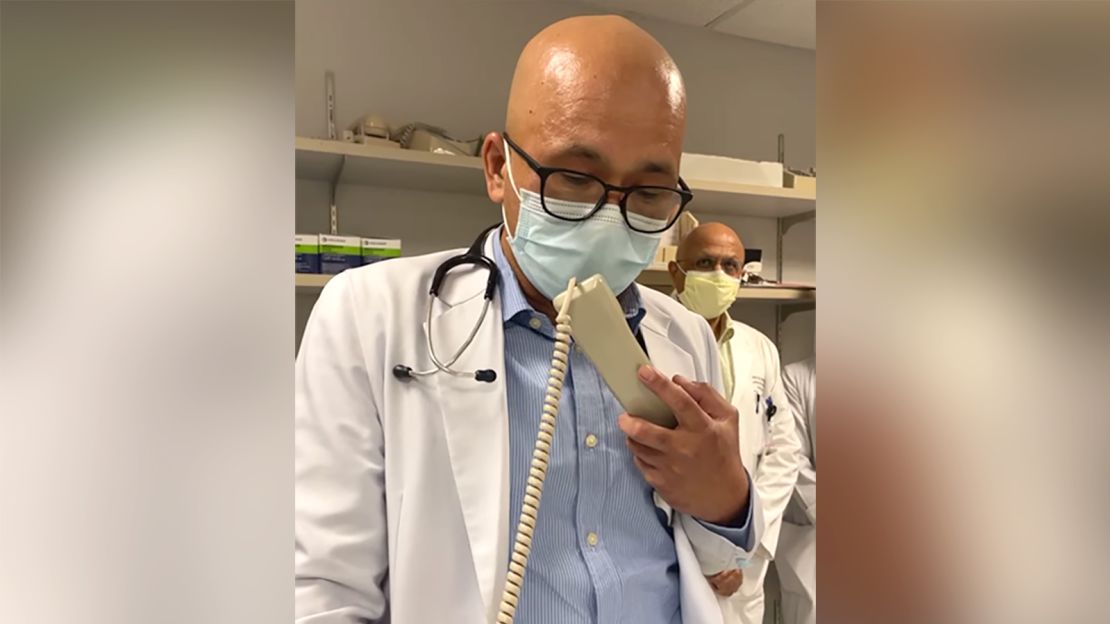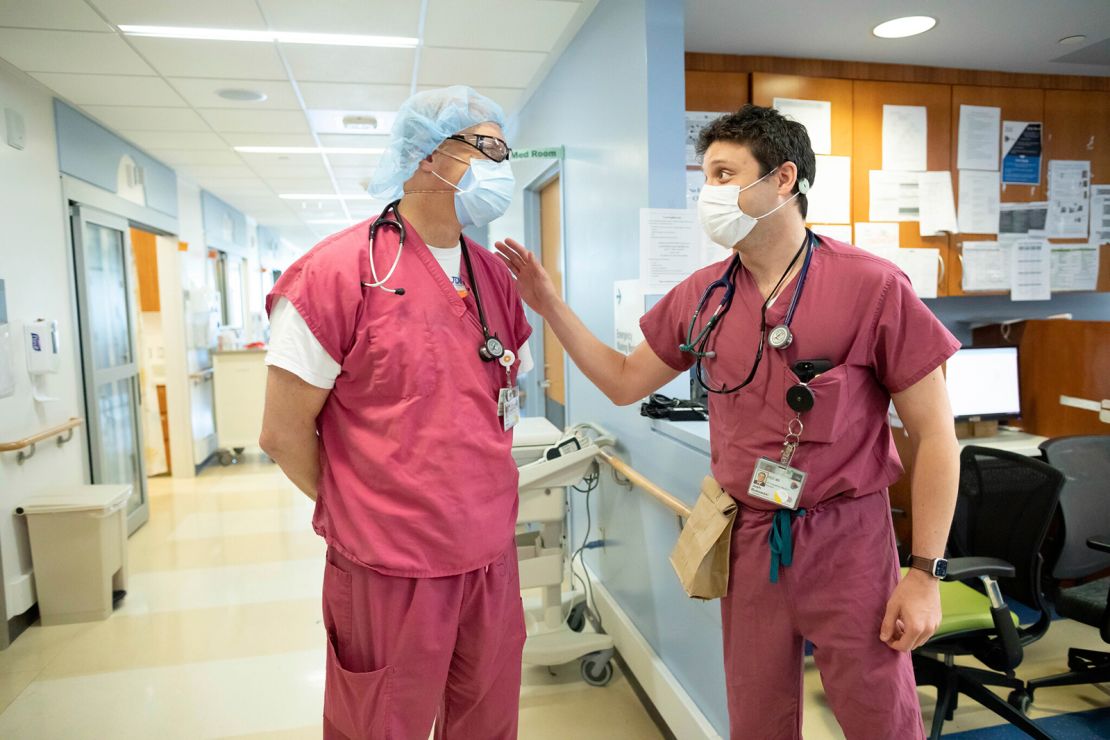Dr. Raul Magadia and his team all gathered in the basement of their Anniston, Alabama, hospital last month for a big announcement he was preparing to make through the intercom system.
That system is usually reserved for emergency codes.
But Magadia, an infectious disease specialist at the Northeast Alabama Regional Medical Center, had other plans on May 25.
He was about to share that in a few minutes the hospital would discharge the last Covid-19 patient from their Covid unit. It was a surreal milestone, he later told CNN, for staff who have been on the front lines of the battle against the virus for more than a year.
“We were really aiming for some good news after 13, 14 months of horrible news,” Magadia said. “That moment … that we had zero (patients), it’s an unbelievable feeling.”

On the other side of the country, inside the Zuckerberg San Francisco General Hospital, similar celebrations took place in late May after hospital staff announced they had no Covid-19 patients – for the first time since March 2020.
“It’s incredibly hopeful for us,” said Dr. Susan Ehrlich, the hospital’s CEO. “It was a very fatiguing year and a half, very stressful.”
Both facilities say they have since seen several Covid-19 patients – but numbers remain so low they don’t compare to the harsh peaks they experienced over the winter.
Across the United States, other hospitals have welcomed similar milestones in recent weeks, which health experts largely credit to Covid-19 vaccinations.
A Utah hospital said in mid-May they had no Covid-19 patients for the first time in more than 430 days, calling the news a “welcomed light.” Shortly after, a Minnesota hospital said it was shutting down its Covid-19 unit following a gradual decrease of patients. In Connecticut, one hospital recently saw its Covid-19 patients drop to one.
More than 22,400 Americans are hospitalized with Covid-19 nationwide, according to data from the Department of Health & Human Services. That’s more than an 83% decrease from the country’s peak in early January, when more than 136,000 Americans were hospitalized with the virus.
But with uneven vaccination rates across the US, some hospitals are still struggling amid recent upticks in Covid-19 patients – almost all of whom are unvaccinated – and worry about another surge fueled by summer gatherings.
It’s what concerns Magadia as well.
“It’s really looking good. We’re seeing the light at the end of this long, long tunnel, but we’re not quite out of the woods yet,” he said.

Some hospitals still see surge of patients
Late last month, the University of Kansas Health System recorded several days with only one or two Covid-19 patients. That’s a far cry from early December, when staff were treating more than 200 Covid-19 patients, according to Dr. Steven Stites, the chief medical officer.
“We had Covid-19 patients everywhere,” he said. “That was clearly the worst, darkest days of the pandemic for us.”
Now, those who are getting hospitalized because of the virus have not been vaccinated, Stites says.
“If you’re here sick with Covid, you’ve not been vaccinated,” he said. “We’ve had one person who had been vaccinated that I can think of off the top of my head.”
It’s a pattern other hospitals have noted, too. In Alabama, Magadia said close to 95% of patients hospitalized because of Covid-19 since vaccinations began have been unvaccinated.
“It’s really a compelling point that vaccines work,” Magadia said.
In central Oregon, Dr. Jeff Absalon, the chief physician executive for the St. Charles Health System, said they are still “in the middle of a surge of Covid patients.” Roughly 98% of hospitalized Covid-19 patients since March have been unvaccinated.
“We have spent a few weeks near our highest point recently,” he said. “We’re still in the thick of the pandemic.”
Absalon is not sure why the numbers remain high.
Local leaders have continued to push vaccination efforts, but Absalon suspects the recent uptick may be due to increased community transmission among unvaccinated crowds as the weather warms up as well as due to the frequent tourists traveling to the area.
He says they are also testing current Covid-19 patients for variants of the virus.
“Our vaccination rates in our county are quite good but, with all that being said, we’re clearly not at a herd immunity level,” he said.

Younger Americans hospitalized
Wyoming, which has one of the lowest Covid-19 vaccination rates in the US, recently saw hospitalization numbers climb again, state data shows.
Dr. Jeffrey Chapman, chief medical officer at the Cheyenne Regional Medical Center in the southeastern part of the state,says he and staff members are worried over a recent rise in Covid-19 patients.
“When we see literally numbers doubling and tripling in a week, we get scared,” he said.
With lower age groups lagging in vaccination numbers, the hospital’s Covid-19 patient demographics have shifted younger.
“Two-thirds of the people we have in the intensive care unit … are 50-60, whereas in the past, it was almost all 70s and 80s,” Chapman said. “And we’ve actually seen a small number of pediatric patients, which we haven’t seen for quite some time.”
“So I think one can postulate that, because younger age groups are vaccinated at a lower frequency … we’re seeing more people at a younger age that are requiring hospitalization,” Chapman said. “Can I say association? Yes. Can I say causation? I don’t have absolute data to back that up, but I don’t think it’s unreasonable to say that.”
Older Americans, who were prioritized for shots, have some of the highest Covid-19 vaccination coverage numbers. As a result, parts of the country have reported their Covid-19 patients have skewed younger, to crowds that aren’t vaccinated.
But now that vaccines are widely available, US officials have stressed the importance of younger groups getting their shots, too – both for their own safety and to help their communities suppress the spread of the virus.
And a recent increase in Covid-19 hospitalizations among people 12 to 17 reinforced the importance of vaccinations as well as prevention measures against the virus, according to a study released Friday by the Centers for Disease Control and Prevention.
“In the month leading up to the recommendations of the Pfizer Covid-19 vaccine for teens and adolescents 12 and older, CDC observed troubling data regarding the hospitalizations of adolescents with Covid-19,” CDC Director Dr. Rochelle Walensky said during a White House Covid-19 briefing.
“More concerning were the number of adolescents admitted to the hospital who required treatment in the intensive care unit with mechanical ventilation,” Walensky said, adding the data “force us to redouble our motivation to get our adolescents and young adults vaccinated.”
‘Post-Covid stress disorder’
As hospitals continue to treat Covid-19 patients, one of the biggest challenges they’re facing is exhausted, emotionally overwhelmed staffs.
In Kansas, Stites said there is an underlying fatigue and mental and physical exhaustion.
“There’s just been a lot of pain and suffering amongst healthcare personnel” who often were the last ones to see a Covid-19 patient alive and had to communicate the bad news to families, he said. “I think that there is a scar, there is a wound that is deep in your mental psyche about what this disease really means.”
It’s somewhat of a “post-Covid stress disorder,” he said.

“This is having a personal toll on the people that are committed to helping others,” Absalon, in Oregon, said. “One of the things that’s particularly difficult right now is that they’re taking care of people that have chosen not to be vaccinated. And it’s very heartbreaking to see that at this point in the pandemic a lot of what we’re seeing in the hospital is preventable.”
In Wyoming, Chapman looks at the hospital’s Covid-19 patients every morning and every night to ensure they’re prepared for another surge.
“I don’t want to see people get sick, and I don’t want to see people die, so that’s part of my anxiety. What can I do to stop this?” he said. “I personally believe the vaccine is the answer to that.”







